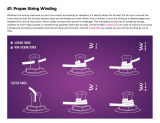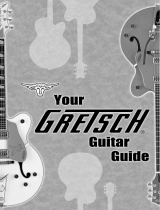Page is loading ...

Beginners 6-String
Acoustic Guitar
Guitar with Accessory Kit

www.PyleUSA.com
2
Please take a few moments to read through this booklet.
In it you will nd answers to many of your questions and other invaluable information about tuning
and changing strings.
Protection from Temperature and Humidity
The most important thing you can do to ensure the structural integrity of your instrument over time, is to maintain
the moisture content of the wood consistently at the appropriate level.
It is 100% certain that an acoustic guitar will be exposed to varied and multiple environmental/climatic conditions from
the time it leaves the maker’s hands until it reaches its ultimate owner. The environment where you live may be a
complete polar opposite from that of the climate where the instrument was produced. It is of paramount importance to
evaluate, measure and stabilize the moisture content in the wood as soon as possible after bringing an instrument into
a new environment.
In the winter, the forced air systems used to heat most homes can drive temperatures up and humidity levels dangerously
low for guitars. Extremely low levels of humidity will result in low moisture content in the wood and ultimately, damage
to the guitar. A good measure of protection against drying out your guitar is to use a room humidier to maintain the
ideal relative humidity of between 40% and 50%.
When the instrument is not in use, we recommend that you keep it in its case with a hygrometer to monitor the humidity
level. Do not leave the guitar out of the case for long periods near a heating vent, radiator or in direct sunlight near a
window. Do not leave your guitar in the trunk or the cabin of a car for long periods and keep it away from excessive heat
and cold.
Please Note: Damage caused to the guitar as the result of exposure to variations in temperature and/or humidity will
not be covered under the PyleUSA warranty.

www.PyleUSA.com
3
Tuning 6-string Guitars
Something as simple as how you wind the strings onto the tuning machine posts when changing your strings, will
determine tuning stability and even string tension. It’s also a good idea to stretch your strings just a little as you tune to
make sure that each string is seated well and snugged down on the tuning machine post. This will save you some tuning
frustration down the road. Just grab the string in the middle, lightly tug it up and down to remove slack, and then retune.
There are a couple of dierent methods for tuning a guitar, depending on whether your guitar is acoustic, or an acoustic
with a pickup and onboard tuner. If your guitar does not have an onboard tuner and you don’t own an electronic
chromatic tuner with a reference tone, you may want to purchase one. It will dramatically simplify tuning your acoustic
or electric guitar.
Always tune from below pitch, up to the correct pitch instead of down from a higher pitch. This will help eliminate string
slack from the tuning machine and decrease the possibility of slippage and tuning changes as you play.
If using the onboard tuner on your guitar, simply plug in, activate the tuner, turn the volume up and starting from the
thickest (bottom) string to the thinnest (top), tune the strings to: E, A, D, G, B, E.
If you do not have an onboard or an electronic tuner, use a guitar pitch pipe, an A-440 tuning fork or some other
pitch reference, and begin by:
• Tuning the second string, “A” to pitch.
• Then, depress the second, or “A” string at the 5th fret, to produce a “D”, and tune the “D” string to that same pitch.
• Next, depress the “D” string at the 5th fret, to produce a “G”, and tune the “G” string until the pitches match.
• Next, depress the “G” string at the 4th fret, to produce a “B”, and tune the “B” string until the pitches match.
• Next, depress the “B” string at the 5th fret, to produce an “E” and tune the thinnest string to a matching “E”.
• Finally, go back and play the thickest “E” string and tune it until the pitch at the 5th fret, an “A”, matches the “A” on the
adjacent string.

www.PyleUSA.com
4
Changing Strings
A fresh new set of strings can breathe renewed life into your instrument. That is why many “tone-conscious” touring
professionals change their strings before every performance. While there is no set rule on how often to change strings,
we have found that most players do not change them nearly as often as they should.
Body oils, acids and salts from sweaty hands and humidity all interact with the metals in guitar strings and cause a
corrosion and breakdown of the materials. Don’t wait until your strings break and fall o from old age before you change
them. Worn, oxidized, pitted and dirty strings will not hold pitch, and simply sound bad. If you are an average player,
playing several times a week, we suggest that you change the strings at least once a month.
When changing strings, we recommend that you remove and replace each string one at a time, instead of all at once.
This will prevent sudden and potentially damaging changes in neck tension. Each new string should be tuned up to
correct pitch before the next one is removed.
When tuning a brand new string, always bring it up to pitch slowly. Otherwise, the rapid stretching may cause the string
to break.

www.PyleUSA.com
5
Re-Stringing Your Guitar
The procedure for re-stringing at-top acoustic guitars and basses is quite similar in the way that the strings are wound
onto the tuning machines.
There are dierences though, in how the strings are attached to the bridges of acoustic at-top and classical guitars.
Please Note: When changing strings, change them one at a time.
Do not remove all of the strings at the same time, as doing so will release all of the tension at once from the neck and
body, which may potentially cause distortion and damage to the instrument.
illustration 4

www.PyleUSA.com
6
Stringing Flat-Top, Steel String Acoustic Guitars:
Flat-top acoustics have a surface mounted pin style bridge with holes and bridge pins to hold the strings in place. To
re-string a attop, remove the bridge pin and the old string. If the bridge pin is dicult to remove, you may want to
purchase a combination string winder/bridge pin puller from your local Dealer, (Figure 4).
Feed the ball end of the new string into the corresponding hole in the bridge, and then reinsert the bridge pin snugly to
keep the string in place.
Make sure that the bridge pin is positioned with the grooved side riding over the string, (Figure 5). Do not hammer the
bridge pin in. A rm twisting push with the thumb should secure it in place.
illustration 5

www.PyleUSA.com
7
Next, pull the string up over the nut towards the headstock and
bend it around the tuning machine post toward the tuning machine
button, (Figure 6) Thread the string through the hole in the post and
begin winding the button to remove the slack in the string.
Continue winding to form a neat coil.
Finally, tune the string to the appropriate pitch. Pull up gently at the
center point of the string to stretch it.
Retune, and repeat, until unwanted slack is eliminated and the
tuning of the strings is stabilized this will prevent slipping and save
you tuning frustrations down the road.
illustration 6
/



